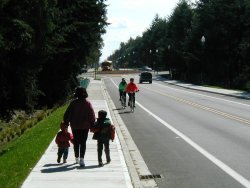Complete Streets Laws and Ordinances
Nationwide
Source: Pedestrian and Bicycle Information Center (PBIC)

A complete street is designed to be a transportation corridor for all users: pedestrians, cyclists, transit users, and motorists. Photo: Dan Burden
Problem
Transportation planners and engineers often design the public right-of-way primarily for motor vehicle users, meaning many roads end up being unsafe, inconvenient, and even impassable for people on bicycles, walking, using wheelchairs, or taking transit. Bicycle and pedestrian planning remains marginalized in most departments, both in terms of planning and funding. Achieving goals other than movement of motor vehicles is extremely difficult in the transportation planning process.
Background
The National Complete Streets Coalition grew out of the America Bikes effort to require that federal transportation dollars support road projects that are designed as complete transportation corridors for all users. The coalition brought the national bicycle organizations together with a diverse set of interests, including AARP, the American Public Transportation Association, the Institute of Transportation Engineers, America Walks, and others. The coalition researched existing laws and policies that required complete streets, and agreed on key elements of successful policies. Jurisdictions across the country are now adopting and implementing a new wave of complete streets policies.
Solution
Commitments to complete the streets have been adopted via state law, local ordinances and resolutions, agency policies, comprehensive plans, tax measures, and design manual re-writes. Regardless of the format, the best complete streets policies apply to all road projects and require high-level approval of any exceptions (more on elements of a good policy can be found at http://www.completestreets.org/policies.html). Once a policy is adopted, full integration of all modes requires revamping decision-making procedures, providing additional training for engineers and planners, rewriting design manuals, and establishing new performance measures.
In Massachusetts, a state law passed in 1996 required the State Highway Department to accommodate bicyclists and pedestrians in projects. Initially, the law was poorly implemented. However, it ultimately helped spark a citizen-led planning process that tossed out the old highway manual that had focused on reducing automotive traffic congestion. The new Project Development and Design Guidebook, adopted in January 2006, established an eight-step decision-making procedure that sets multi-modal accommodation as a guiding principle. The guide does not have separate chapters for different modes; instead, the needs of bicyclists, pedestrians, transit users, and disabled people are integrated into every aspect of design, with many new tools to help planners balance the needs of all users.
The city of Seattle recently adopted a comprehensive complete streets ordinance, shortly after including a complete streets provision in a transportation bond measure. The ordinance directs the city to integrate complete streets practices into all Seattle Department of Transportation (SDOT) plans, manuals, rules, regulations, and programs as appropriate. And it specifies that "all sources of transportation funding be drawn upon to implement Complete Streets." This is an important provision — rather than creating a new funding pot, complete streets policies can leverage existing, mainstream transportation dollars, minimizing the cost of new bicycle, pedestrian, and transit facilities and reducing the need for costly retrofits. The Seattle ordinance specifically includes maintenance and operations in the policy; this is valuable as many minor but crucial improvements for biking and walking can and should be made during routine maintenance and operations projects.
Many more examples of good policies can be found in this summary: http://www.completestreets.org/completestreets/Tab1-%20Early%20Success%20Stories/Complete_Streets_Policies.pdf
Results
Complete streets policies have resulted in systematic retraining of engineers (South Carolina), comprehensive new decision-making procedures (Charlotte, NC), increased funding for multi-modal projects (Oregon), and added leverage for including multi-modal facilities on specific projects (Sacramento, Colorado Springs). Complete streets policies help provide the complete network that research shows is needed to encourage people to walk, bicycle, and take transit. For example, Boulder, CO has been building complete streets longer than most; this commitment has helped the city increase bicycle commuting (from 10.6 percent of work trips in 1990 to 20.5 percent in 2006). Studies show that cities with more miles of bike lanes per capita have higher bicycle commuting rates. Complete streets also improve safety, reduce the need for paratransit service, improve mobility for disabled people, seniors, and children, help people get more daily physical activity, and encourage economic revitalization. Fact sheets with more information on each of these benefits can be found here: http://www.completestreets.org/benefits.html
Web sites
Massachusetts Highway Department Project Development and Design Guide:
http://www.vhb.com/mhdGuide/mhd_GuideBook.asp
Seattle's Complete Streets ordinance:
http://clerk.ci.seattle.wa.us/~scripts/nph-brs.exe?d=CBOR&s1=115861.cbn.&Sect6=HITOFF&l=20&p=1&u=/~public/cbor2.htm&r=1&f=G
Contact
Barbara McCann, Coordinator
National Complete Streets Coalition
1707 L Street NW, Suite 1050
Washington DC 20036
202-234-2745
barbara@mccann.net
www.completestreets.org
Image source
Dan Burden




